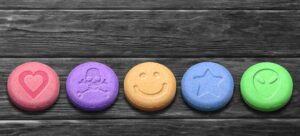Molly, a popular club drug known for its euphoric effects, is frequently used in social settings like clubs and raves. Often associated with heightened energy and mood enhancement, it’s a favorite among partygoers seeking a more intense sensory experience.
Understanding how long Molly stays in the system is crucial for managing its effects, assessing potential risks, and addressing health concerns. In this article, we’ll discuss the duration of Molly’s effects, how long it remains detectable through various tests, and what users can expect during and after use.
Looking for LGBTQ-affirmative substance use treatment in LA? Call La Fuente Hollywood Treatment Center at 888.903.9898.
What Is Molly?
Molly is a common street name for a drug containing MDMA (3,4-methylenedioxymethamphetamine), a compound with both stimulant and hallucinogenic properties. It’s often used at clubs and raves for its euphoric effects.
Though Molly is believed to be a “pure” form of MDMA, it often contains other substances such as illegal drugs, legal drugs, or even household items like sugar, baking powder, and soap.
While similar to ecstasy, the key difference lies in their forms. Ecstasy typically comes as a tamper-resistant pill, whereas Molly is usually a powder, making it easier to mix with other substances.
Molly’s Effects
Molly’s effects include increased energy, euphoria, mood enhancement, heightened sensitivity to touch, and altered time perception. These effects are largely due to MDMA’s influence on three key neurotransmitter systems:
- Serotonin: MDMA boosts serotonin activity, affecting mood, sensory perception, and sleep. This leads to elevated mood, increased emotional intimacy, and heightened empathy.
- Dopamine: Responsible for activating the brain’s reward system, dopamine increases energy levels and can drive repeated use of the drug.
- Norepinephrine: This neurotransmitter raises heart rate and blood pressure, contributing to Molly’s physical effects.
The heightened activity of these neurotransmitters can lead to an overstimulation of the central nervous system, disrupting the body’s ability to regulate essential functions. Common side effects include:
- High blood pressure
- Rapid heartbeat
- Difficulty regulating body temperature
- Intense sweating and dehydration
- Panic attacks
- Seizures
- Insomnia
Longer-term effects can include a severe “crash” with depression lasting for days or weeks. Research suggests that chronic use may also lead to lasting damage to the liver and brain, with changes possibly appearing months or years later.
How Long Does Molly Last?
When taken orally, ecstasy typically takes about 30 minutes to start working, though it can begin as quickly as 20 minutes or take over an hour. The effects usually peak between 60 and 90 minutes and last three to six hours.
Users often take a follow-up dose as the initial effects fade to extend the high and delay the “crash” until the following day. In addition to the dose, factors like body weight, individual body chemistry, and the presence of other substances can influence the strength and duration of the effects.
Even after the high subsides, physical effects like a rapid heartbeat or insomnia can persist for a few hours. Many users also experience a “comedown” the next day, or for several days, marked by low mood or feelings of depression.
How Long Is Molly Detectable?
How long Molly can be detected depends on the amount taken and the type of test. The time it stays in your system also varies based on factors like frequency of use, individual metabolism, and other physiological factors.
Here’s a general guideline:
- Urine: Molly is typically detectable in urine for 3 to 5 days after use.
- Blood: Molly can be detected in blood for about 1 to 3 days.
- Saliva: Molly remains detectable in saliva for approximately 1 to 2 days after ingestion.
- Hair: Hair follicle tests can detect Molly for up to 90 days, though this method is less common due to its cost and complexity.
Molly Risks and Harm Reduction
Using Molly carries significant risks, including overdose, mental health issues, and physical harm. Harm reduction strategies include staying hydrated, not mixing Molly with other substances, and using test kits to check for purity.
Inclusive Molly Treatment at La Fuente Hollywood
Molly, like other club drugs, disproportionately affects the LGBTQ community, especially gay men. This increased substance abuse is partly due to the amount of LGBTQ socializing that happens in clubs and bars, as well as issues like internalized homophobia, discrimination, and emotional trauma.
If you or a loved one needs help quitting Molly, La Fuente Hollywood Treatment Center is here to help. Our Los Angeles facility offers specialized inpatient and outpatient programs tailored to the unique needs of the LGBTQ community.
Get the help you need at La Fuente. Call us at 888.903.9898.




